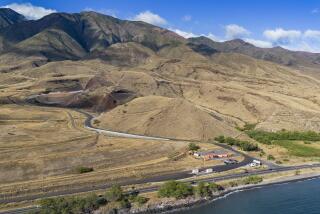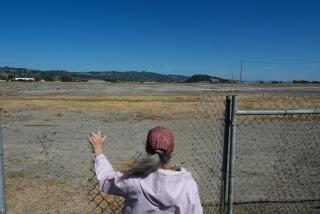McCollâs Neighbors Deserve Fast Action : Decision Is Due Now on How to Clean Up Toxic Site
Years have gone by, and the McColl toxic waste dump remains an open sore amid the expensive homes in northwest Fullerton. Lawsuits compensating area homeowners are being settled along the way, but the actual cleanup seems no closer than ever. The site has been examined so many times that area lawmakers long ago complained that âanalysis paralysisâ had set in. Now another study--this time itâs being called a âtestâ--is to begin this week. It is urgent that the test propel the cleanup of McColl forward as quickly as possible. Then, no more studies and no more delays.
Waste oil disposed of at McColl--one of the stateâs worst hazardous-waste sites--was the result of an all-out effort by the petroleum industry to produce jet fuel for the War Department during World War II. At the time, such dumping was legal. Also at the time, the nearest development was a pig farm.
The need to clean up the eight-acre site became apparent in the late 1970s when housing was built nearby. When residents began complaining of noxious odors, the state found evidence of arsenic, benzene and sulfur dioxide at McColl. What danger there is to ground water still is unknown. Last week, the federal Environmental Protection Agency, which administers the Superfund toxic waste cleanup fund, intervened. It told the landowner, McAuley LCX Inc., and the five oil companies that the EPA says are responsible for the wastes--Shell, Phillips Petroleum, Texaco, Arco and Unocal--to determine the full nature and extent of ground water contamination and its potential for harm to public health and the environment.
The 20-day test will try to determine whether thermal destruction of 150,000 tons of contaminated soil and sludge at McColl can be take place without causing more pollution. Crews will dig up and grind about 135 tons of earth inside a three-story-high tent being built to minimize air pollution. Area residents are being asked to report odors or other problems. The test is designed to assess technological problems that might result from incineration or other high-temperature processes.
This is not just an academic exercise. There is a pressing public interest in cleaning up this site, which has been on the federal Superfund cleanup list for eight years. The EPA, which favors thermal destruction as the preferred method of cleanup, will offer its final recommendation in March. Meanwhile, the oil companies are trying to drum up neighborhood support for a plan to cap the site with a clay or synthetic cover. That would cost $22 million--about a fifth as much as incineration. But the problem would remain underground and unresolved, for future generations to handle. Thatâs why capping wonât do and why a thorough cleanup is essential.
The EPA insists that the oil companies pay for whatever method of cleanup it selects. That has led some residents to fear that there will be years of litigation ahead if the companies donât get their way with capping. To forestall that possibility, the EPA should reassure residents that ground water contamination or other immediate pollution problems posed by McColl will be addressed without compromise.
In 1982, a local legislator complained that $1.5 million had been spent on studies of McColl âand not one shovel full of dirt has been turned.â Add eight years, and still nothing has changed.
The time has come for all studies, tests, negotiations--whatever--to be done so the cleanup project can get moving. Neighbors have waited long enough to be rid of McCollâs chemical legacy.
More to Read
Sign up for Essential California
The most important California stories and recommendations in your inbox every morning.
You may occasionally receive promotional content from the Los Angeles Times.










